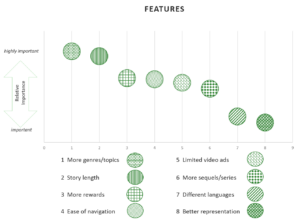Making Choices during Tough Times: Feature Prioritization
February 16th, 2021

In the last 10 months, people have been seeking ways to stay entertained as lockdowns around the world put limitations on what we can do. According to Jon Stainer, Managing Director of Sports at Nielsen, “Consumers are looking for ways to pass the time and to help distract themselves from what is going on in the real world.”
Choices: Stories You Play
My personal choice during this time? A video game titled “Choices: Stories You Play.” Choices is a game of stories that have different outcomes depending on choices you make. You get to customize your character and decide who you want to be and how you want to interact with other characters. I’ve had this downloaded for years, but the last couple of months I found myself spending more time using it. That may be because, according to Nielson Games Video Tracking, 82% of global consumers played video games and/or watched video game content during the height of the COVID-19 lockdown. In the US alone, the number of gamers claiming to play video games more now due to the COVID-19 pandemic has increased by 46%1. That got me thinking about why I am playing this game more than previously. Is it just because of COVID? I have some theories.
Why Do I Play the Game More?
The mechanics of Choices are simple. Players make choices throughout the game that influence both their experience and journey through the story. Typically, the experience for free users (those who do not make in-app purchases) was inferior to that of paid users because the best options required some form of currency. Over the last couple of months, I have noticed the quality of the user experience for free and paid users has increased and I suspect this is due to the pandemic.
How did the game developers come to this decision? Did customers’ feedback drive this decision? Were they capitalizing on the increasing trend of video game usage during the pandemic? To take advantage of this market expansion, Choices had to change the mechanics of the service they offer. At TRC, one of the tools we could utilize is Bracket™.
Use Bracket™ for Feature Prioritization
Bracket™ prioritizes features to show what is most important to a respondent (in this case, increasing time spent playing the game). Some potential features to test using Bracket™ could be: Story length, Ease of navigation, Limited video ads, More genres/topics, Better representation, More rewards, Different languages and More series/sequels. The technique randomly groups these items into sets and users select the most favorable in each set. Winners advance in the tournament-style exercise until there is a winner. Results are then calculated among all research participants, and each feature is scored on a scale of 0-100.
Imagine the results showed More genres/topics was most important and Story length was second. This could be very telling. These users want more genres that are longer and dive deeper into the characters/storyline. Based on recent changes, Choices has added a VIP option for those willing to pay a monthly fee to get new releases, exclusive content and more opportunities to play. These results could back that decision. These scores make it easy to rank and show the results in (as seen below).
Separate Out What Not to Focus On
In our experimental Bracket™ study, the results demonstrate to the developers what is important to focus on in driving more time spent in the game, and just as important, which features not to focus on. The next question is which of these important features are game players willing to pay with real or in-game currency.
Stay tuned for Part II to see how conjoint can be used to take a deeper look into the top features.
Source: 1Nielson: https://www.nielsen.com/us/en/insights/article/2020/3-2-1-go-video-gaming-is-at-an-all-time-high-during-covid-19/





